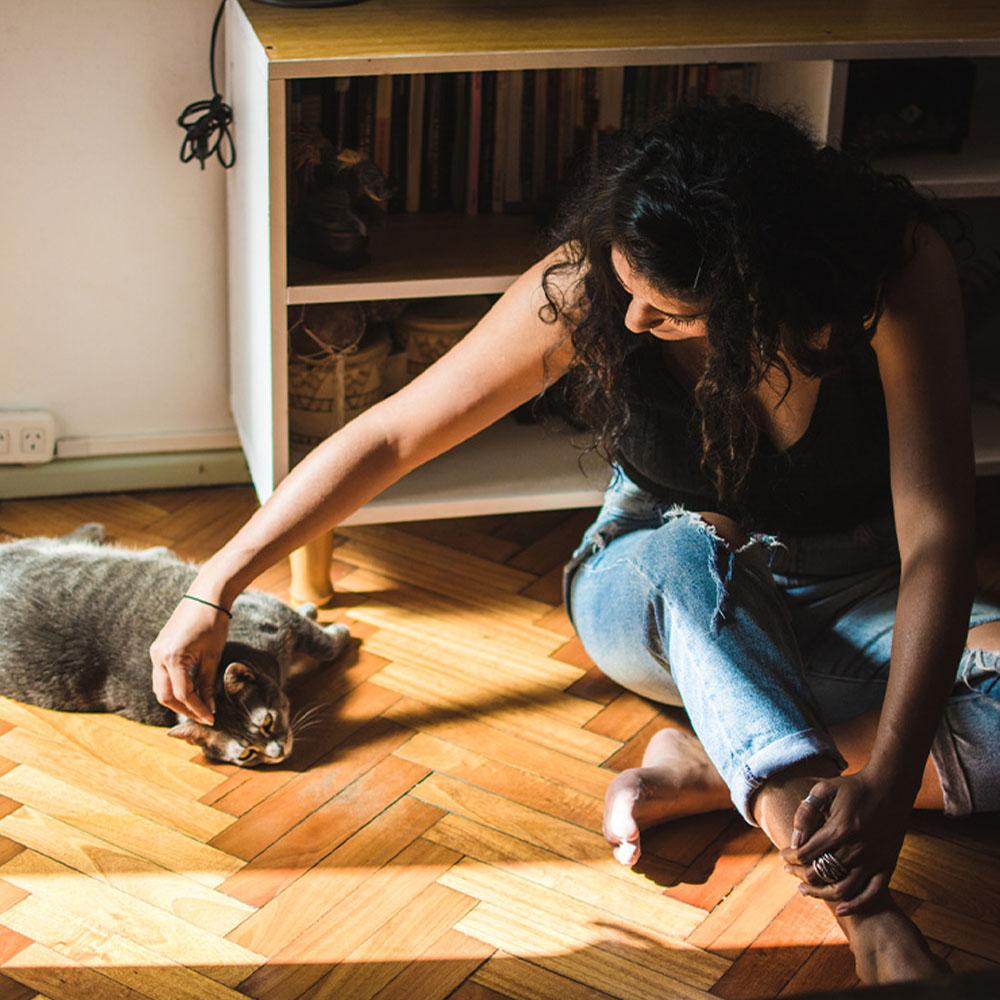How To Get A Cat To Like You: Cat Adoption Meet & Greet
Preparing to visit the cat shelter? Learn more about the meet and greet process and how you can get a new cat to like you.
Preparing to visit the cat shelter? Learn more about the meet and greet process and how you can get a new cat to like you.
by Savannah Admire, | July 28, 2023

Ana Luz Crespi / Stocksy
If you’re a cat lover, you know it can take some time for a new cat to feel comfortable around you. While every cat has their own personality, even well-socialized cats may hesitate to approach an unfamiliar person. If you’re planning to adopt a new feline friend, learn how to approach a cat for the first time and how to get a cat to come to you, to encourage trust and — eventually — affection.
Cats tend to keep their guard up when meeting someone new and are very perceptive of your actions. Before you visit a cat in a shelter or rescue, take the time to learn how cats communicate their feelings and moods, as well as how to make friends with a cat.
To start your first meeting off on the right foot, maintain friendly body language and avoid staring, as much as you may want to look at that adorable face. Cats will pay close attention to your movements to determine if you’re safe to approach.
You should also pay attention to the cat’s physical cues. Study the cat’s body language and look for positive signs like purring, slow tail waves, and a lowered head, all of which can indicate that the cat is comfortable with you. Signs like rapid head movements or staring may indicate overstimulation, while a tense body, hiding, and ears flattened to the head can indicate a frightened cat, letting you know that you should keep your distance and be patient.
When you first approach a new cat, you should do so on their level — literally. Standing can be intimidating, so kneel or sit on the floor, making yourself smaller and closer to the cat’s size. This will make you appear less threatening and give the cat a chance to study you and approach you on their own terms.
Once the cat comes closer, offer your hand for them to sniff. Don’t force the cat to touch you or make any sudden movements that could startle the cat. You may even have to sit very still and pretend to ignore the cat by looking at your phone or talking to someone else in the room. When the cat does approach you, you can hold out a loosely closed fist for the cat to smell so they can become better acquainted with you.
Make sure to speak softly and calmly. Cats are sensitive to loud noises and are more likely to approach you if they sense that you’re calm and safe. Give the cat space to come to you in their own time, and don’t try to pet the cat if they don’t want to be touched.
Above all, meeting a new cat for the first time requires an abundant amount of patience. You have to be willing to wait for the cat to approach you and give them space until they do.
Never try to pet a cat before they ask you to. Cats will let you know when they want attention by giving you a light nudge with their head. This may come in the form of a gentle head bump, or they may rub against you with the side of their face or chin.
When a cat nudges you, let them sniff your hand, and if they nudge you again, feel free to reach out and pet them. For the first interaction, only pet the cat lightly on the head and avoid any other spots on their body.
Treats can be a good way to encourage a new cat to develop positive associations with being around you. A little snack can also help coax a more timid cat to approach you. Just make sure not to feed the cat from your hand, but instead, set a treat or two on the floor nearby so the cat can investigate and approach without having to come in direct contact if they’re not ready. This is also an effective tactic if you’re wondering how to approach a stray cat without scaring them.
The best way to encourage a cat to warm up to you is to allow them to approach you. Cats like to call the shots, and you can respect that desire by keeping your distance and only petting the cat when they give the okay, as well as knowing where not to touch a cat. You can also use treats and try playing with them; wand toys are also great for first encounters because they allow the cat to play without coming too close to an unfamiliar person. While a little playtime may not be the answer to how to make a cat love you instantly, it’s certainly a good start.
Use a calm, soft voice
Maintain relaxed body language
Avoid loud noises and sudden movements
Play with them from a distance
Encourage them with treats
Many cats may seem a little fearful or even skittish at a first meeting, so be patient and don’t force the cat to interact with you, as this will only make them more frightened. Instead, give the cat plenty of space, allowing them to hide if they want or explore the room. They may even slowly draw closer to you simply out of curiosity. Maintain your calm and non-threatening posture by sitting on the ground and greet the cat in a soft voice to help soothe them.
When you meet a cat for the first time, it can be tempting to scoop them up in your arms and give them kisses. But this behavior is guaranteed to frighten the cat and can even result in scratches or cause damage to the future relationship you were hoping to have. Instead, make sure to avoid these behaviors as you’re learning how to get a cat to like you:
Never stare at the cat. Cats can see staring as threatening or intimidating. Instead, offer an encouraging slow blink to show the cat you trust them.
Avoid making any sudden movements, which can startle the cat and cause them to run away and hide.
Never pick up a cat if they’re not comfortable with it. Being picked up can make a cat feel trapped and scared, and many cats don’t like being held at all.
Know where to touch a cat and where not to pet a cat. Avoid full-body petting and keep your first pets around the cat’s head and chin.
Don’t force the cat to interact with you if they’re not interested because this will only make them feel more stressed. Instead, give them space to approach you in their own time and on their terms.
By taking the time to understand a cat’s signs and how they communicate through their body language, you can ensure that your first interaction with a new cat goes as smoothly as possible. By starting off on the right foot (paw?) with your new feline friend, you can begin to develop a loving relationship that can last for years to come.
Be patient, avoid making any sudden movements or loud noises, and let the cat come to you on their own.
Never try to pet a cat until they ask you to with a nudge or head bump.
If the cat seems fearful, keep your distance and “ignore” the cat to allow them to grow used to your presence.
Treats can help coax a hesitant cat out of their shell and develop positive feelings about being around you.
If the cat seems willing to play, use a wand toy that allows them to interact with you while still keeping their distance.
Offer the cat treats and toys to play with, but give them space to explore and warm up to you in their own time.
Maddie’s Fund: Cat Handling Handbook
Austin Pets Alive: Guide to Socializing Cats
Helping a Fearful Cat in New Home

Savannah Admire is a writer, editor, and pet parent to two dogs and a cat. When she’s not writing, you can find her reading, playing Animal Crossing, or being an obnoxious nerd about her favorite movies and TV shows. She lives in Maryland, where she constantly debates whether or not to get a third dog.